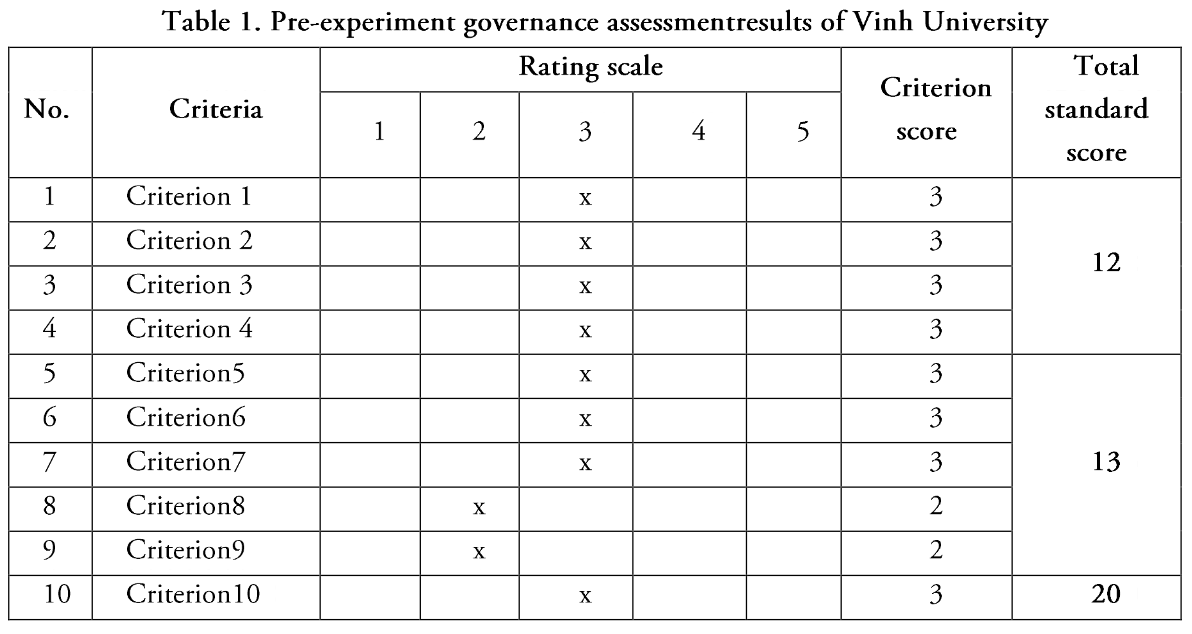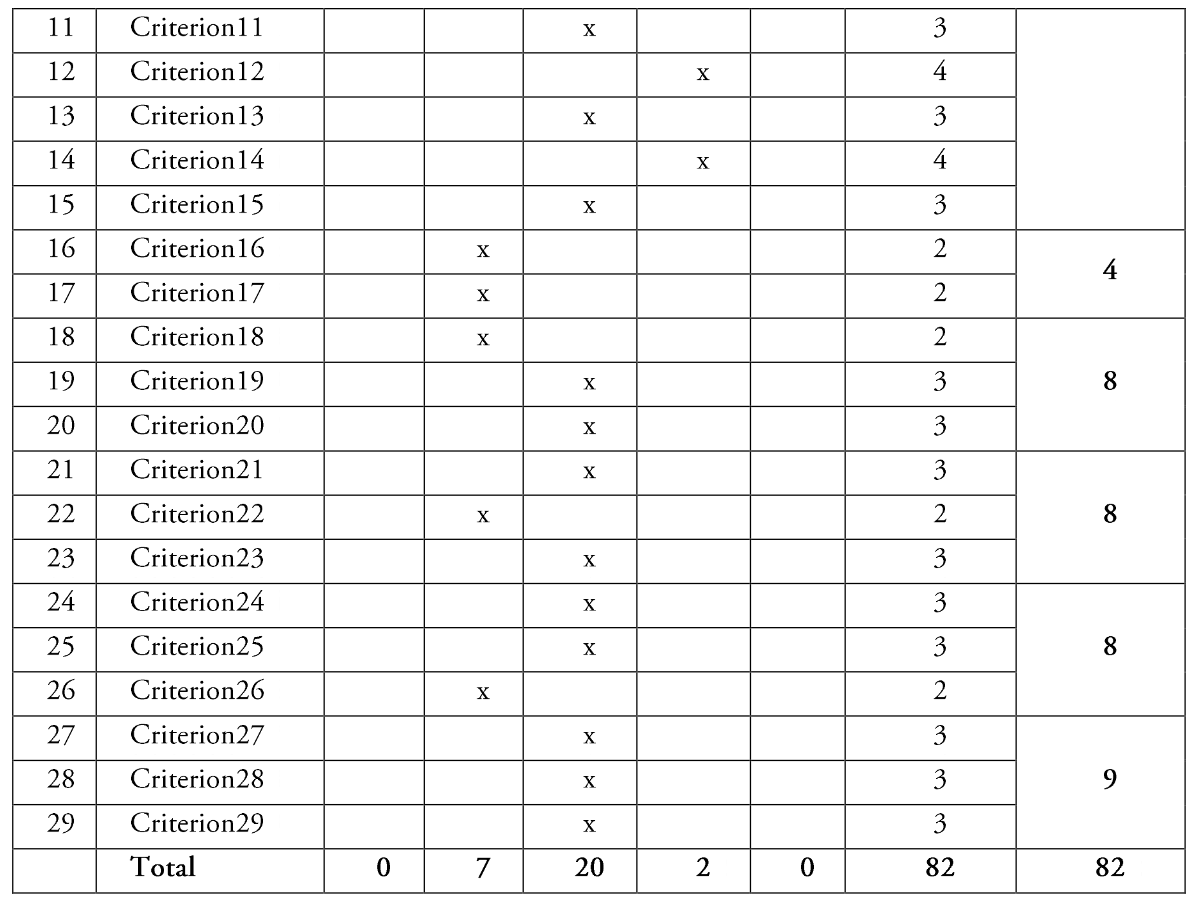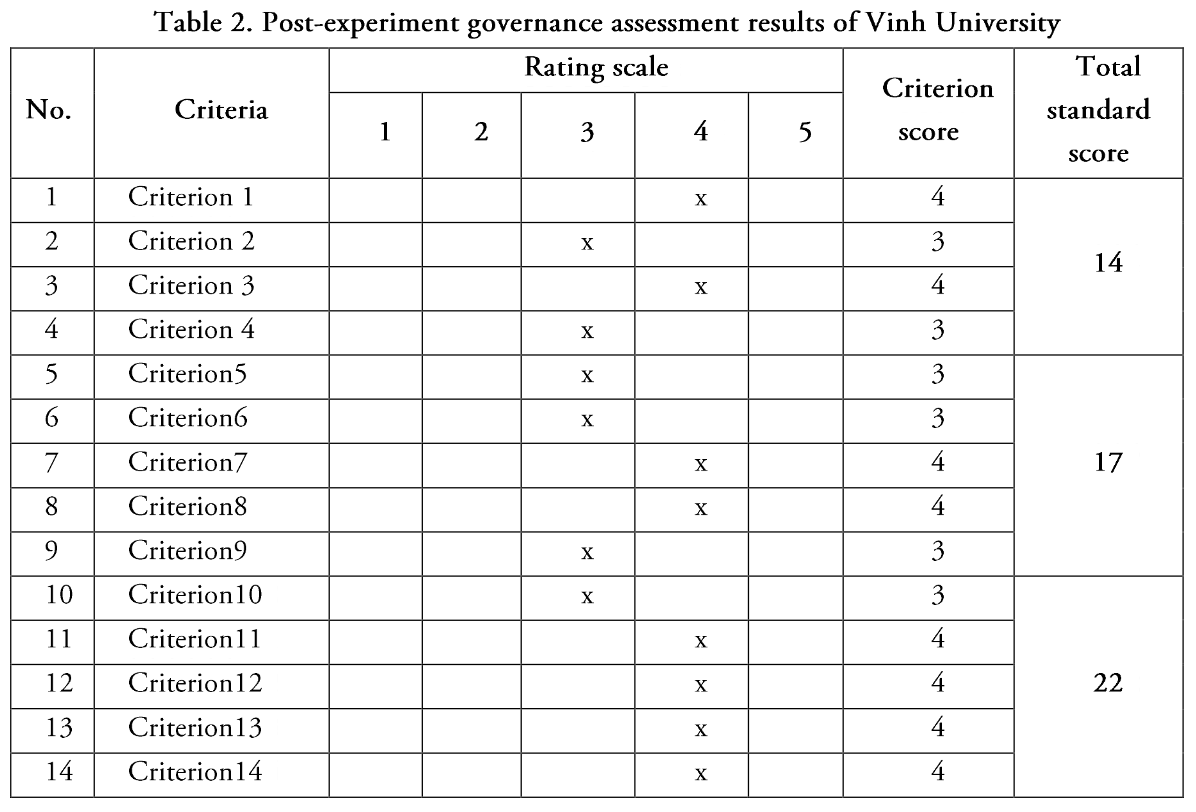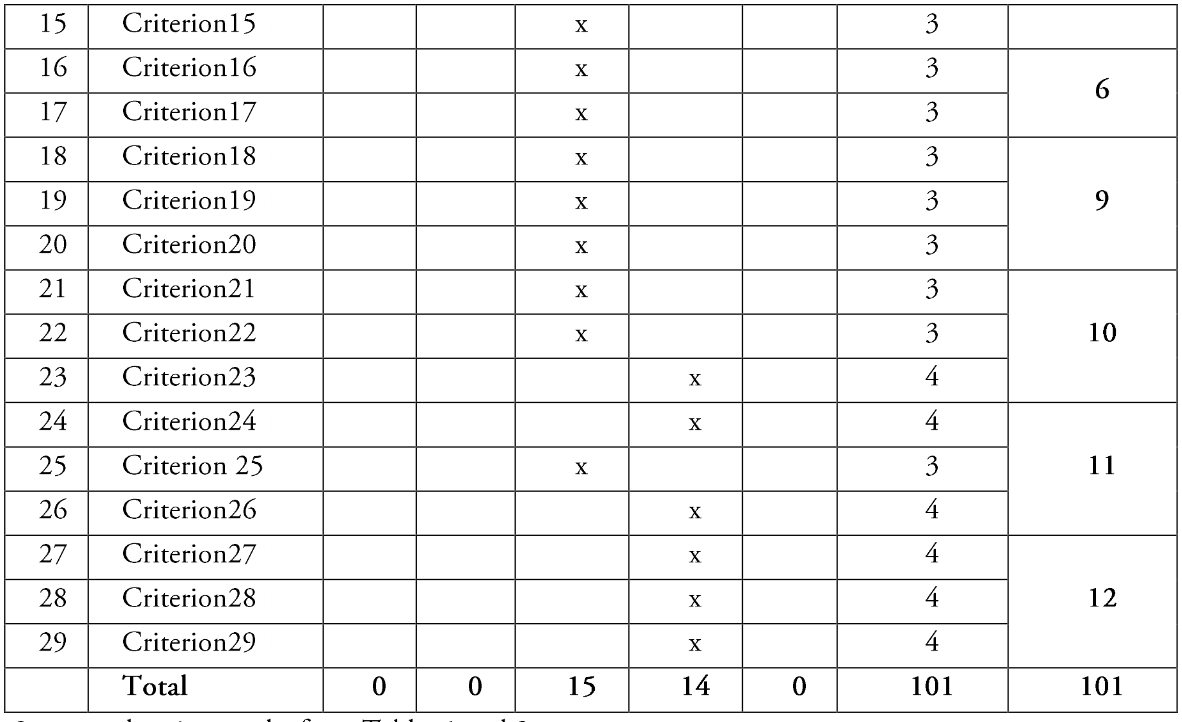Proposing and Experimenting with a Public University Governance Model and Mechanisms
TS. Phạm Lê Cường, GS. Đinh Xuân Khoa
Abstract
Higher education in Vietnam and the world is now evolving towards a diverse trend. Self-innovation, most importantly, the governance model and mechanism, has become the key to the survival of every university. Through a literature review and an experimental study, a Vietnamese public university governance model and mechanisms were proposed. The experiment conducted at Vinh University confirmed the effectiveness and feasibility of the proposed Vietnamese public university governance model and mechanism
Tob Regul Sci.™ 2022; 8(1): 758-768
DOI:doi.org/10.18001/TRS.8.1.64
1. Introduction
Fundamental changes m the Vietnamese higher education system in the past two decades, especially those involved in university ownership, training modes and employers' requirements have made the current university governance method obsolete and created an urgent need forinevitable changes to meet the increasing demands of society and the trend of the times. Both Vietnam and the world have experienced an unprecedented diversity in higher education. For the same problems, universities are required to take different solutions. This depends greatly onuniversity leadership and also makes a difference in the development of each university. The current situation ofVietnamese public universities results from the existing operating method. It is only the change in the way they operatethat brings out a breakthrough. Self-innovation, most importantly, the governance model and mechanisms, has become the key to the survival of every university. A variety of issues related to university governance such asuniversity autonomy, accountability, university council, etc., yet, have been in the initial step of research and pilot. Meanwhile, those charged with governance of public universities are lacking management theory and experience. Consequently, thiscontributes negatively to the governance efficiency of public universities. This study, thus, proposes a governance model and mechanisms for public universities in Vietnam and an experiment on such model andmechanisms is an urgent and topical issue amid the current context..
2. Study
2.1. Public university governance model and mechanisms
2.1.1. Public university governance model
Through a literature review and an actual situation survey, a model of the public university governance system and a model of public university governance factors were proposed.



universities. Each of the powerful actors in a public university operates within its defined mandates and powers. This is the key to the smooth and fruitful operation of every university's governance system, and also an indispensable condition to ensure the consensus, stability and development of the university. It is evidenced by the fact thatdespitehaving different manifestations, most of the recent disagreements in certain public universities in our country have been rooted in the disagreements among this powerful trio.
The University Council becomes more powerful than ever according to the revised Higher Education Law. Hence, itis more important to establish a hierarchy of authority among the Party Committee, the University Council and the Rector. Each powerful actor must both well fulfill its role and interact with the others, for the ultimate goal of the school development.Therefore, despite operating in a hierarchical structure, each public university needs to agree onboth hierarchical and democratic mechanismS.
ii.Autonomy associated with accountability and public higher education quality accreditation
Modern higher education is most significantly characterized by university autonomy which promotes the development of a natural system in a globalized educational environment with healthy competition and under the State orientation and strict quality control. The autonomy of higher education institutions must, nonetheless, be associatedwith accountability. Higher education institutions must operate in an open and transparent manner to the State, learners, and users of educational products and take responsibility for their performance. Their accountabilityrepresents the responsibility to ensure training and output quality and effective and transparent use of resources andinformation.
Besides accountability, university autonomy is also linked to educational quality accreditation, which keeps the entire autonomy and accountability of public universities in close touch with the goal of ensuring and improving educationalquality. Also, the association with educational quality accreditation enables Vietnamese public universities tokeep pace with world higher education and be enlisted in international university rankings. Following an autonomy mechanism associated with accountability and educational quality accreditation, public universities will take the maximum advantages of human resources and facilities, better attract social resources, more wisely use the State's funds, expand technology transfer and other services to improve their financial qualification for sustainable development, ensuringgood satisfaction of requirements for enhancing the quality of training, scientific research andtechnology transfer. It can be affirmed that the autonomy mechanism associated with accountability and educationalquality accreditation is the "golden key" to innovation in university governance, solving a bunch ofexisting andfuture problems in the higher education system.
iii. Motivating and promoting the activities of public universities in all fields through a constantly improved policy system
A public university is a multi-party entity. Activities of public universities, ranging from scientific research and technology transfer to school governance have observed the increasing involvement of stakeholders (e.g., socio economic organizations, employers, and parents). In exchange for their participation in activities of public universities, in addition to the responsibility for the schools, stakeholders also desire to enjoy certain benefits, especially spiritualones such as attribution, honor, priority in the recruitment of graduates, technology transfer. That is why clear policies for these stakeholders should be communicated right at the time relationships with stakeholders are established. Stakeholders' participation recognized through specific and consistent policies will effectively drive them to further make more practical and effective contributions to the school development. It is worth noting that, however,the perceptions, interests and expectations of one party may differ widely from those of the other. Therefore, universities should establish policies that cover the interests of all parties.
Issuing policies on training, scientific and technological activities, and autonomy in organizational structure,personnel and finance constitutes one of the main components of public university governance. Appropriate policies will positively support school activities and promote stakeholders to actively engage in school development, thereby, contributing to enhanced efficiency of school governance..
iv.Cooperation and responsibility-sharing between public universities and stakeholders
A cooperative and responsibility-sharing relationship should be established between public universities and their stakeholders, first of all, their units, organizations and individuals (lecturers, students, administrators, etc.).0ncesuch cooperative and responsibility-sharingrelationship is established, a consensus among their units, organizations and individuals will be created.This ensuresthe smooth and effective operation of the universities and prevents anypossible conflicts in the schools as well.
In parallel with a cooperative and responsibility-sharing relationship with internal stakeholders, such relationship with external stakeholders is also required to be established since external stakeholders have become more active, directly or indirectly, in public universities' activities, ranging from training and scientific research to organizational structure and personnel.Such participation not only contributes to improving the public universities'training quality but also more closely connects them to businesses, the labor market and social needs. In addition, external stakeholders are the financial resources outside the State budget for public universities. Apart from using training products of public universities, they both supervisethe universities' operation and are those to whom the public universities are accountable.
v. Building, promotion and operation of public universities' brands and core values
The spiritual strength of a university is made up of its brand and core values. Amid the current strong competition innational, regional and global higher education, the brand and core values have represented more significance for every public university. A university without a brand and core values that all of its members pursue will not have a place in any higher education system.
Brand and core values embody boththe spiritual and physical strengths of a university. When a university'sbrand and core values are promoted and made use of, it will attract morelearners and stakeholders/social forces to joinits activities. This representsthe basis and premise for a university's brand and core values to transform from spiritualstrength to physical strength. Building, promoting and making use of brands and core values must be, thus, considered immediate and long-term goals of every public university
2.2. Experimenting with a public university governance model and mechanisms
2.2.1. Experiment organization Experiment purposes
To assess the impact of the public university governance model and the proposed operating mechanism on public university governance.
- Experiment hypothesis
The efficiency of public university governance can be improved if the proposed public university governance model and operating mechanism are adopted.
- Experiment content and method
The experiment content was the proposed public university governance model and operating mechanism. The experiment was carried out once, on the same object, using the following model:
Results were measured by determining the difference between the post-experiment results (experiment) with the pre-experiment results (input). If a difference (expressed through 102-01l>O) existed, it could be concluded that the public university governance model and operating mechanism were effective for public university governance.
- Experiment location and time
The experiment was conducted at Vinh University.
Experiment period: Semester 1 of the academic year 2020-2021 (from September 2020 to January 2021).
- Assessment of experiment results
A set of public university governance assessment standards consisting of 8 standards and 29 criteria (see the Appendix) was employed to evaluate the experiment results. This set of standards was developed in reference to the set of higher education institution quality assessment standards issued by the Ministry of Education and Training, EUhigher education institution autonomy assessment framework, and a literature review on university governance.Different university governance experts and public university administrators were consulted during the development of the set of public university governance standards. These proposed standards comprehensively reflected all aspectsof this activity in the context of higher education innovation and international integration. Each standard comprised several criteria, each of which was considered at 5 levels, corresponding to 5 levels of scores: Level 1: 01; Level 2: 02; Level 3: 03; Level 4: 04; and Level 5: 05. The maximum score was 29 x 5 = 145.
The public university governance results were classified into 5 categories, corresponding to the obtained scores:
1) Very poor:scores of 29 to 52; 2) Poor: scores of 53 to 75; 3) Average: scores of 76 to 98; 4) Good: score of 99 to 122; 5) Very good.·scores of 123 to 145.
In the study, this set of standards was used to evaluate the governance of Vinh University before and after the experiment.The governance of Vinh University was evaluated through the following steps: 1) Set up anAssessment Sub Committee; 2) Develop an assessment plan; 3) Collect, analyze and process information and evidence; 4) Conduct assessment and classification; 5) Comment on the university's governance.
2.2.2. Experiment results
i. Pre-experiment governance assessment results of Vinh University
The pre-experiment governance assessment results of Vinh University are shown in Table 1.


ii. Post-experiment governance assessment results of Vinh University
The post-experiment governance assessment results of Vinh University are shown in Table 2.


Table 3 was made using results from Tables 1 and 2.

2.2.3. Analysis of experiment results
- Quantitative analysis of experiment results
As shown in Table 3, the post-experiment score was higher than the pre-experiment one. Among the 29 criteria forevaluating Vinh University's governance, 7 criteria got a score of 2 before the experiment, while there were only 2 criteria at a score of 4; The remaining criteria obtained a score of 3. Meanwhile, after the experiment, 14 criteriaobtained a score of 4 and no criterion got a score of 2. The total scores of Vinh University's governance were 82 (ranked average) and 101 (ranked good) before and after the experiment, respectively.
- Qualitative analysis of experiment results
The qualitative analysis of the experiment results was conducted in accordance with the Public University Governance Assessment Standards. Strengths and weaknesses of the proposed governance model and operating mechanism proposed for Vinh University were considered by each standard.
Standard 1: 1) Strengths: The University's mission was determined in line with its functions, mandates, resources and development orientation. Its vision was based on its mission and experienced regular revisions and amendments. The University's strategic development plan was thoroughly communicated and complied with; 2) Weaknesses: The University's mission, vision and strategic plan has not been widely disseminated in the community.Inclusive comments from employers and alumni have not been collected during reviewing and supplementing the vision and mission.
Standard 2: 1) Strengths: The University had a strategic plan in place to meet its mission, vision and strategic goals. Its operating decisions were made following the prescribed process. Staff strategies and lecturer and staff recruitmentand appointment procedures, standards and criteria were established. The University made a plan to step by step obtain financial autonomy under the law; 2) Weaknesses: Concrete short-term and long-term goals were absent from theUniversity's strategic development. Several administrative documents have not been regularly reviewed forimprovement. The planning of staff professional titles and employment schemes in its units have been just in the initial steps. No detailed analysis of the efficient use of funds for its operations was included in its annual financial plan.
Standard 3: 1) Strengths: Functions, responsibilities and authorities of departments, managers, lecturers and staff were clearly defined, under regulations and specific conditions. The University's Party Committee has well fulfilled its role of comprehensive leadership in its activities, embodied by the issuance of specific and appropriate guidelines and resolutions. The University Council was established following regulations, initially promoting its role and function of the University's governance through resolutions. The Rector exercises his authority and responsibilities under the law and administered the University by means of regulations, rules and decisions. The coordination mechanism among theUniversity's Party Committee, the University Council and the Rector happened in strict compliance withprovisions of the Higher Education Law; 2) Weaknesses: The young University Council had limited operational experience, and some of its members have not yet fulfilled the role of administrators. No members of the University Council were students. The University's existing governance system has not been operated smoothly. Units,organizations and individuals have not made prompt notice and reports. No guidance on the implementation of the leader's directive documents was provided. The coordination mechanism among the University's Party Committee, the University Council and the Rector has not been widely practised.
Standard 4: 1) Strengths: The benefits and responsibilities of units, organizations and individuals within the University were clearly defined. Cooperation programs in training, academic exchange, and exchange of lecturers and learners were strengthened. There was extensive cooperation with businesses, effectivelysupporting study, research and work search activities for students.An increasingfocus on developing cooperative relationships with domestic andforeign organizations and individuals was observed;2) Weaknesses: The relationships of interests and responsibilities between the University and stakeholders were found incomprehensive, asynchronous and improper. In addition, relationships have not been regularly reviewed and improved.
Standard 5: 1) Strengths: The University's branding and core value building strategy was associated with its development strategy. Its brand and core values were reviewed to match its development strategy in each specific period.Different resources have initially been called for to build, promote and exploit the University's brand and core value;2) Weaknesses: There was no short-term implementation plan for the University's branding and core value-building strategy. All internal and external resourceshave not been called for to build, promote and exploit the University's brand and core values.
Standard 6: 1) Strengths: The accomplishment of the University's goals as planned was monitored bydedicated inspection and examination departments in the University. The monitoring and inspection results have made a significant contribution to the realization of its overall goals. 2) Weaknesses: There is an absence of a specific and strict procedure to carry out the plan to monitor the accomplishment of the University's goals.Its performance measurement system has just begun to be established.No update has been made to the plan to assess the accomplishment of its goals.
Standard 7: 1) Strengths: The purposes, requirements, autonomy and accountability of the University have been elaborated in the "Vinh University Autonomy Scheme" in line with the general trend and its actual conditions.Its autonomy and accountability implementation plan was developed and is being followed. The University's autonomy and accountability were quantified based on the set criteria;2) Weaknesses: The Autonomy Scheme has not beenwidely communicated to all members of the University and has not undergone the appraisal and approval by the competent authorities. It has not been implemented in a synchronous manner. Also, the degree of its autonomy and accountability has not been regularly monitored and assessed.
Standard 8: 1) Strengths: A self-assessment was carried out and reported on the basis of the university quality assessment standards. In addition, the University prepared a specific quality improvement plan accordingly.It also developed a specific, appropriate and feasible post-external assessment quality improvement plan. The results of its educational quality assessment and recognition of meeting educational accreditation standards were publicly announced to stakeholders through various communications channels; 2) Weaknesses:There was a lack of evidence toconfirm the achievement of several criteria in the University's Self-Assessment Report.Regarding certain standards and criteria, the shortcomings were not comprehensively considered andanalyzed in terms of the root causes to propose a tailored remedial plan.Educational quality assessment results were publicized on limited media. Tosum up,remarkable results have been achieved from the adoption of the public university governance model andoperating mechanism in Vinh University. This further confirms the necessity and feasibility of the proposed public university governance model and the operating mechanism.
3. Conclusions
The public university governance model was developed employing determiningfactors of the governance of a public university, the role of eachfactor and their interaction, as well. The interaction among these factors took place in two axes: Goals - content - methods - governance resources and school governors - governed entities. For an effectivepublic university governance model, the proposed mechanisms should be deployed. The experiment results at Vinh University evidence that this public university governance model and operating mechanisms are scientific, practical and highly feasible.
REFERENCES
- Nguyen Thi Kim Anh (2010), Application of the Balanced Scorecard model in University Governance, Proceedingsof the Scientific Conference on "Solutions to Improve the Efficiency of Higher Education Management in Vietnam", Ho Chi Minh City.
- Ministry of Education and Training (2017), Circular No. 12/2017/TT-BGDDT Regulating the Quality Accreditation of Higher Education Institutions.
- Pham Thi Ly (2016), Governance at Vietnamese Universities - Similarities and Differences with the UK's, Workshop on "A Comparative Study on University Governance in Vietnam and the UK" held at the University of Danang.
- Dinh Xuan Khoa (2019), Governance of Public Universities in the Current Context, Dissertation of PhD in Educational Management, Vinh University.
- Nguyen Dong Phong and Nguyen Huu Huy Nhut (2013), University Governance and Vietnamese Economic University Model, UEF Journal, 18.
- National Assembly of the Socialist Republic of Vietnam (2018), Law on Higher Education.
- Nguyen Huu Quy (2010), Balanced Scorecard Model-Based University Management, Journal of Science and Technology, University ofDanang, 2/2010.
- Do Tien Sy (2015), School Governance - Requirements in the Context of Education and Training Innovation,Journal of Educational Sciences,
- Dobbins, M., Knill, C., & Vogtle, E. M. (2011), An analytical framework for the cross-country comparison ofhigher education governance, Higher Education, 62(5), 665-683.
- Professional skills development for University lecturers: A case study in the Mekong Delta region of VietnamNghiên cứu10/06/2025
- Management of primary teacher training programs using the CDIO approach: Theoretical frameworks and practical implementationsNghiên cứu03/06/2025
- Nghiên cứu mối liên quan giữa tật cận thị và một số yếu tố khác với tình trạng lo âu của sinh viên 2 năm đầu đại họcNghiên cứu22/05/2025
- Mối liên quan giữa tình trạng lo âu với tật cận thị và một số yếu tố khác của sinh viên năm cuối đại họcNghiên cứu13/05/2025
- Đổi mới quản lý cơ sở giáo dục đại học trong bối cảnh tự chủ đại họcNghiên cứu01/05/2025
- Xây dựng và sử dụng khung năng lực trong phát triển đội ngũ giáo viên làm công tác tư vấn học đường ở trường tiểu họcNghiên cứu07/04/2025
- Tổng quan các nghiên cứu phát triển năng lực số cho sinh viên đại học ngành giáo dục tiểu họcNghiên cứu04/04/2025
- Bản đồ cơ thể đầu tiên về ảo giácNghiên cứu01/04/2025
- Điểm chuẩn ngành Sư phạm Tin họcKhoa Tin học23/08/2025
- Khoa Ngữ văn công bố mục tiêu và chuẩn đầu ra chương trình đào tạo trình độ thạc sĩ Ngôn ngữ Việt NamĐào tạo21/08/2025
- Nghiên cứu mới cho rằng cần có một định nghĩa mới về chứng khó đọc (dyslexia)Tin tức20/08/2025
- Học viên cao học K30 bảo vệ luận văn/đồ án Thạc sĩ ngành Quản lý giáo dục với loạt đề tài sát thực tiễnĐào tạo17/08/2025
- Thuốc điều trị ADHD giúp giảm nguy cơ tự tử, lạm dụng chất gây nghiện và hành vi phạm tộiTin tức15/08/2025
- Thông báo KQ xét cộng điểm thưởng cho thí sinh có thành tích vượt trội xét tuyển vào đại học chính quy trường Đại học Vinh năm 2025Tin tức15/08/2025
- Các chatbot trí tuệ nhân tạo (AI) có thể bị khai thác để trích xuất thêm nhiều thông tin cá nhân.Tin tức14/08/2025
- Mèo mắc chứng sa sút trí tuệ có những đặc điểm điển hình tương đồng với bệnh AlzheimerTin tức13/08/2025


